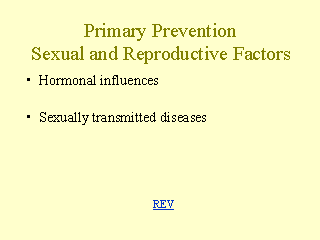Search inside of Supercourse and lectures in HTML and PPT format
 |
|

|
front |1 |2 |3 |4 |5 |6 |7 |8 |9 |10 |11 |12 |13 |14 |15 |16 |17 |18 |19 |20 |21 |22 |23 |24 |25 |26 |27 |28 |29 |30 |31 |review |
 Hormonal factors affect the risk and behaviour of certain tumors such as breast, endometrial, ovarian and prostate cancers. For example, nulliparity adversely affects the risk of breast cancer as does having a first child at a relatively older age. Estrogens to treat postmenopausal symptoms can increase endometrial hyperplasia and cancer as well as the risk of developing breast cancer. Oral contraceptives may reduce the risk of ovarian and endometrial cancers but increase the risk of breast cancer. Mothers treated in the 1970s for threatened abortion with diethylstilbestrol had daughters who later had a high incidence of vaginal cancer. Sexual behaviour is also a risk factor for cancer. In addition to to the risk of AIDS and subsequent related cancers, either starting sexual intercourse at a young age or having multiple sex partners both increase the risk of cervical cancer. In effect, cervical cancer can be thought of as a sexually transmitted disease (STD), with certain subtypes of the human papilloma virus as the likely responsible agents. Thus measures effective in the control of STDs will also prevent cervical cancer. Moreover, in developing contexts with great poverty improving feminine hygiene can have a major effect on reducing cervical cancer. A National Cancer Control Program can offer education to address these risks. The benefits of protected intercourse for reducing cervical cancer as well as STDs and AIDS can be stressed. Education in schools can address the nature and hazards of risky sexual and reproductive behaviors, and the importance of barrier methods of contraception for safe sex. The risks from prolonged use of non-contraceptive estrogens can be pointed out. |